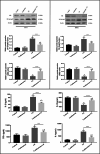Candesartan Protects Against Cadmium-Induced Hepatorenal Syndrome by Affecting Nrf2, NF-κB, Bax/Bcl-2/Cyt-C, and Ang II/Ang 1-7 Signals
- PMID: 35590119
- PMCID: PMC9931870
- DOI: 10.1007/s12011-022-03286-4
Candesartan Protects Against Cadmium-Induced Hepatorenal Syndrome by Affecting Nrf2, NF-κB, Bax/Bcl-2/Cyt-C, and Ang II/Ang 1-7 Signals
Retraction in
-
Retraction Note: Candesartan Protects Against Cadmium-Induced Hepatorenal Syndrome by Affecting Nrf2, NF-κB, Bax/Bcl-2/Cyt-C, and Ang II/Ang 1-7 Signals.Biol Trace Elem Res. 2025 May;203(5):2933. doi: 10.1007/s12011-024-04347-6. Biol Trace Elem Res. 2025. PMID: 39145864 Free PMC article. No abstract available.
Abstract
Cadmium (Cd) is a serious pollutant in the environment. Candesartan is an angiotensin II (Ang II) receptor antagonist with promising diverse health benefits. The current study is planned to investigate the hepatorenal protective effects of candesartan against Cd-induced hepatic and renal intoxication. Our results demonstrated that candesartan effectively attenuated Cd-induced hepatorenal intoxication, as evidenced by improving hepatic and renal function biomarkers. Besides, candesartan reversed hepatic and renal histopathological abrasions induced by Cd toxicity. Candesartan antioxidant effect was mediated by Nrf2 activation. Also, candesartan suppressed hepatorenal inflammation by modulating NF-κB/IκB. Moreover, candesartan attenuated Cd hepatorenal apoptosis by upregulating Bcl-2 and downregulating Bax and Cyt-C proteins. Interestingly, these effects are suggested to be an outcome of modulating of Ang II/Ang 1-7 signal. Overall, our findings revealed that candesartan could attenuate Cd-induced hepatorenal intoxication through modulation of Nrf2, NF-κB/IκB, Bax/Bcl-2/Cyt-c, and Ang II/Ang 1-7 signaling pathways.
Keywords: Ang II/Ang 1–7; Bax/Bcl-2/Cyt-C; Cadmium; Candesartan; NF-κB; Nrf2.
© 2022. The Author(s).
Conflict of interest statement
The authors declare no competing interests.
Figures














Similar articles
-
Perindopril Dampens Cd-induced Nephrotoxicity by Suppressing Inflammatory Burden, Ang II/Ang 1-7, and Apoptosis Signaling Pathways.Biol Trace Elem Res. 2024 Jul;202(7):3193-3203. doi: 10.1007/s12011-023-03907-6. Epub 2023 Oct 17. Biol Trace Elem Res. 2024. PMID: 37848587
-
Retraction Note: Candesartan Protects Against Cadmium-Induced Hepatorenal Syndrome by Affecting Nrf2, NF-κB, Bax/Bcl-2/Cyt-C, and Ang II/Ang 1-7 Signals.Biol Trace Elem Res. 2025 May;203(5):2933. doi: 10.1007/s12011-024-04347-6. Biol Trace Elem Res. 2025. PMID: 39145864 Free PMC article. No abstract available.
-
Mirtazapine attenuated cadmium-induced neuronal intoxication by regulating Nrf2 and NF-κB/TLR4 signals.Toxicol Mech Methods. 2023 Oct;33(8):675-687. doi: 10.1080/15376516.2023.2231530. Epub 2023 Jul 4. Toxicol Mech Methods. 2023. PMID: 37403423
-
Isoliquiritigenin alleviated the Ang II-induced hypertensive renal injury through suppressing inflammation cytokines and oxidative stress-induced apoptosis via Nrf2 and NF-κB pathways.Biochem Biophys Res Commun. 2018 Nov 17;506(1):161-168. doi: 10.1016/j.bbrc.2018.09.013. Epub 2018 Oct 16. Biochem Biophys Res Commun. 2018. PMID: 30340829
-
Angiotensin II induces gene transcription through cell-type-dependent effects on the nuclear factor-kappaB (NF-kappaB) transcription factor.Mol Cell Biochem. 2000 Sep;212(1-2):155-69. Mol Cell Biochem. 2000. PMID: 11108147 Review.
Cited by
-
Alleviative effects of pinostrobin against cadmium-induced renal toxicity in rats by reducing oxidative stress, apoptosis, inflammation, and mitochondrial dysfunction.Front Nutr. 2023 May 24;10:1175008. doi: 10.3389/fnut.2023.1175008. eCollection 2023. Front Nutr. 2023. PMID: 37342552 Free PMC article.
-
Perindopril Dampens Cd-induced Nephrotoxicity by Suppressing Inflammatory Burden, Ang II/Ang 1-7, and Apoptosis Signaling Pathways.Biol Trace Elem Res. 2024 Jul;202(7):3193-3203. doi: 10.1007/s12011-023-03907-6. Epub 2023 Oct 17. Biol Trace Elem Res. 2024. PMID: 37848587
-
A Tripeptide (Ser-Arg-Pro, SRP) from Sipunculus nudus L. Improves Cadmium-Induced Acute Kidney Injury by Targeting the MAPK, Inflammatory, and Apoptosis Pathways in Mice.Mar Drugs. 2024 Jun 20;22(6):286. doi: 10.3390/md22060286. Mar Drugs. 2024. PMID: 38921597 Free PMC article.
-
Soluble suppression of tumorigenicity 2 is a potential predictor of post-liver transplant renal outcomes.PLoS One. 2023 Nov 2;18(11):e0293844. doi: 10.1371/journal.pone.0293844. eCollection 2023. PLoS One. 2023. PMID: 37917773 Free PMC article.
-
Angiotensin-(1-7) ameliorates intestinal barrier dysfunction by activating the Keap1/Nrf2/HO-1 signaling pathway in acute pancreatitis.Mol Biol Rep. 2023 Jul;50(7):5991-6003. doi: 10.1007/s11033-023-08544-9. Epub 2023 Jun 3. Mol Biol Rep. 2023. PMID: 37269386
References
Publication types
MeSH terms
Substances
LinkOut - more resources
Full Text Sources
Research Materials
Miscellaneous

